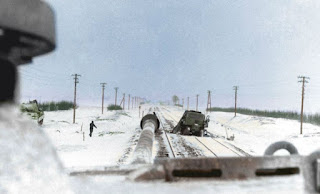 |
| Panther n°800 of SS-Ostuf. d. R. Karl Nicolussi-Leck east of Warszawa |
At the end of February 1944, 5.SS-Panzer-Division Wiking found it self in the area between Chełm and Lublin in Poland with the survivors who had been fortunate enough to escape the
Cherkassy pocket. It was intended to reconstitute the division there. Then a call from the Führer Headquarters reached the division on March 12 1944. Wiking was to assist the defence of Kowel in Eastern Poland, which was under threat from a strong Soviet force during the Polesskoe offensive.
At the same time, Chełm and its environs were subject to massacres and revenge killings between Ukrainians and Poles. According to Polish historian Marek Jasiak the most notable single day example of this occurred March 13-14 1944, when the Polish Home Army or the AK, aided by Polish self-defense groups murdered some 1,500 ethnic Ukrainians from Chełm region villages, 70 percent of whom were women and children. Stabswache de Euros has been unable to verify Jasiak's numbers of those killed using other sources. The massacre is believed to be an act of retaliation for earlier murders by the Ukrainian Insurgent Army, or the UPA, with the support of the local Ukrainian population against the Polish minority in the area. The atrocities on Poles were directly linked to the policies of the Ukrainian nationalist Stepan Bandera and carried out indiscriminately and without restraint. The massacres were marked with extreme sadism and brutality. The victims, regardless of their age or gender, were routinely tortured to death. Poles were burned alive, flayed, impaled, crucified, disembowelled, dismembered and beheaded. Women were gang raped and had their breasts sliced off, children were hacked to pieces with axes, babies were impaled on bayonets and pitchforks or bashed against trees. Hundreds of thousands of Poles fled to areas that were controlled by the Germans. Swedish historian Per Anders Rudling's studies from 2011 quote 91,200 confirmed Polish deaths, 43,987 of which are known by name. The Germans tried not to get directly involved in the conflict, and special German units formed from the collaborationist Ukrainian and later the Polish auxiliary police were deployed in pacification actions. According to Polish professor Władysław Filar, Soviet partisan units in the area reported to the headquarters that the Ukrainian
Banderivtsy did not shoot the Poles but cut them dead with knives and axes, with no consideration for age or gender.
On the morning of March 16 1944, two days after the massacres in the Chełm region, SS-Panzergrenadier-Regiment Germania and Westland were loaded on trains. SS-Gruppenführer
Herbert Otto Gille flew by Fieseler Storch from Lublin to Kowel. He landed there as planned and set up the command post. Gille acted with vigor and planned in great depth in order to improve the defensive posture of Kowel. But time was pressing. About 2,000 wounded men lay in the city's cellars, receiving only emergency care. Gille had his own doubts whether the city could be held until relief arrived. The first unit to arrive was the 8th Company of Wiking's SS-Panzer-Regiment 5. Commander was the daring officer SS-Obersturmführer
Karl Nicolussi-Leck. He had already proven himself as an armor leader in the
Caucasus. His company was well trained and newly equipped with 17 Panthers. It was further intended for the Germania of SS-Sturmbannführer
Franz Hack and its 10 attached assault guns to accompany the attack. By April 10 1944 the Soviet encirclement of the city was broken and Wiking were pulled out of the line to continue refitting. In 1945, at the insistence of Soviet dictator Joseph Stalin Poland's borders were redrawn, the Polish population was forcibly resettled and Kowel was incorporated into the Soviet Union. Credit: Wikipedia i.a. Top image: view from the turret of a Panther of SS-Panzer-Regiment 5, trundling along the railway embankment to Kowel in March 1944. c. Bundesarchiv. Second image: SS-Hstuf. Alois Reicher and SS-Ustuf. Alfred Großrock of SS-Pz.Reg. 5 confers with their Heer counterparts. Photo taken by SS-KB Alois Jarolim, who covered the battle of Kowel at close quarters. U.S. NARA. Third image: two Panthers from SS-Pz.Reg. 5 as seen through the commanders scissors periscope from a third tank. Note the Panzergrenadiers walking alongside the tanks. Photo taken west of Kowel in April 1944 by SS-Uscharf. Ernst Baumann, staff member of Germania. c. Bundesarchiv. Bottom image: Panther n°800 and a communication vehicle Sd.Kfz. 251/3 east of Warszawa in 1944. Panther n°800 belonged to SS-Ostuf. Karl Nicolussi-Leck. c. Bundesarchiv.




SS-Untersturmfuhrer Alfred Grossrock destroyed 26 Soviet T-34 tanks on 8 July 1944 during the Battle of Maciejow close to Kowel in the northwest. For this achievement, he will be decorated with the Knight's Cross on 12 August 1944. He was later captured by the Russians in Hungary at the end the war and subsequently killed in a POW camp in April 1945. P.S. I highly recommend the Polish war drama Volhynia (Hatred) to anyone with an interest in the Ukrainian ethnic cleansing of Poles in World War II.
ReplyDelete